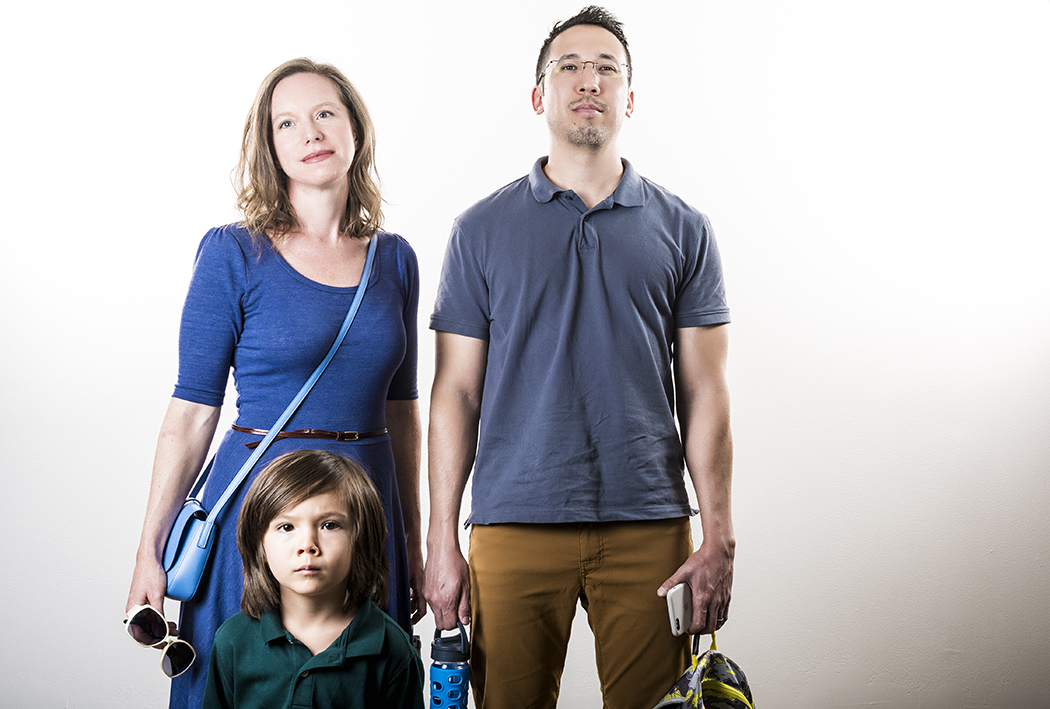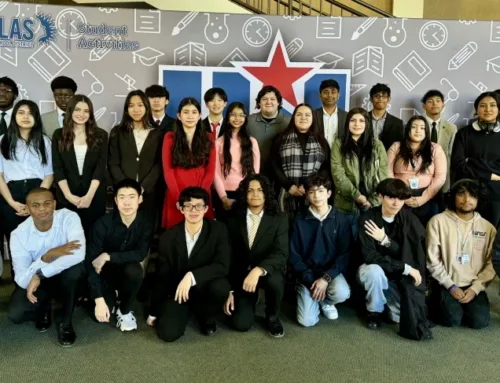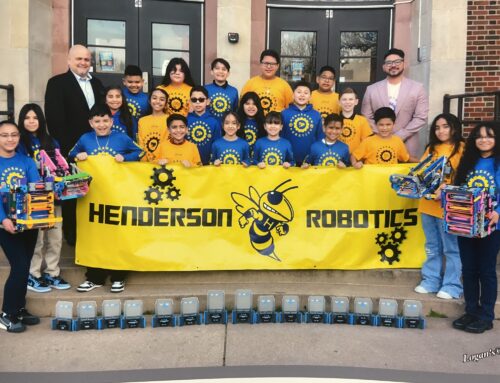Our new podcast looks at how and why families select a school

Sacha Rappmund started kindergarten at Hogg Elementary this fall. Hundreds of families who live in homes nearby choose to send their children elsewhere, but Sacha’s parents, Denise and Peter Bo Rappmund, like what the school has to offer their son. (Photo by Danny Fulgencio)
Denise Rappmund called James S. Hogg Elementary the week before school started to make sure they had all of her son, Sacha’s, transfer paperwork. They did, and they confirmed that Sacha would be in a dual-language immersion class with about a dozen kindergartners.
The state of Texas allows up to 22 students in each kindergarten class, but because Hogg isn’t popular among families in its attendance zone, particularly homeowners in the Kidd Springs neighborhood, its classrooms are roomy.
“Part of the reason I wanted this school is because it was so under capacity and nobody really knows about it,” Rappmund says. She notes that Sacha was one of only 12 kids in his private preschool class, but she paid $15,000 a year for tuition. Hogg is free.
“Why doesn’t anyone else see this?” she asks. “Am I crazy?”
Rappmund studied several schools in the Oak Cliff area where she lives and wound up choosing Hogg. Its dual-language immersion program mixes native Spanish and native English speakers in the same classroom with almost everything taught in Spanish, similar to the immersion program at Spanish House, where Sacha attended last year.
Hogg’s teachers, like Spanish House teachers, also are trained in project-based learning, a curriculum approach that invites them to investigate real-world questions and problems rather than simply teaching children the answers by rote.
The icing on the cake is her son’s intimate class size: Sacha’s teacher has only 11 students in her charge, half the state required maximum and fewer than many private schools.
Yet most parents whose children are actually zoned to Hogg are opting for private or home school. More than 90 percent of Hogg’s students are poor, but most of the families who live in Kidd Springs homes are not.
The Rappmund family is like these families in that they, too, could afford to opt out of the public school system. But Denise Rappmund hopes that they instead will be part of a movement to reverse the longstanding trend of middle and upper class families who overwhelmingly forgo Oak Cliff’s Dallas ISD schools.
“I wish that every parent that [Sacha] went to private school with, if they all just flooded their neighborhood schools, how amazing,” she says.
Visit Hogg Elementary with Denise and Sacha Rappmund, and hear more from Denise about her decision-making process in our new podcast, available at oakcliff.advocatemag.com/podcast.
James S. Hogg Elementary, by the numbers
274
Current enrollment at James S. Hogg Elementary
463
How many students Hogg Elementary can hold
226
Number of students zoned to Hogg last year who opted for private or home school
94.4
Percentage of Hogg’s 2016-17 enrolled students who live in poverty
54.2
Percentage of of Hogg’s 2016-17 enrolled students who are English language learners (ELL)
11:1
Ratio of students to teachers in Sacha Rappmund’s two-way dual language immersion kindergarten class
Sources: DISD 2016-17 Campus Demographic Data Book*, Texas Education Agency (TEA) school profile*, DISD My Data Portal.
*We used 2016-17 data rather than 2017-18 because DISD data is not updated until after TEA’s required enrollment snapshot, which takes place in October.
“I hate living so close to my kids’ school that they can walk to it. I’d prefer a daily drive across town.”
Said pretty much no one ever. Yet that’s the situation in which many Oak Cliff homeowners find themselves.
In recent years, Oak Cliff has built a reputation as an urban, progressive neighborhood, which appeals to young professionals. They move in, settle down and start families, but they tend to move away or opt for private school by the time their children enter kindergarten.
Why? What are parents looking for? What are — and aren’t — they finding in their neighborhood schools? How do parents choose a school for their children?
This is the focus of our new school-year-long series that attempts to help Oak Cliff parents take a better and deeper look at their neighborhood schools. Each month, our magazine will highlight a different family who is considering or attending a Dallas ISD school. We’ll probe all of the questions, hesitations and soul-searching that revolve around school decisions. We’ll help our partner families figure out answers to their questions and concerns, and we’ll publish their stories in our magazine, on our website and in a new podcast, all available at oakcliff.advocatemag.com.
We hope other families will be able to identify with and learn from these journeys. And we’re still looking for other partner families. If you’re considering your neighborhood school but have questions and doubts you want to explore, please reach out to editor Keri Mitchell at 214.292.0487 or kmitchell@advocatemag.com.





